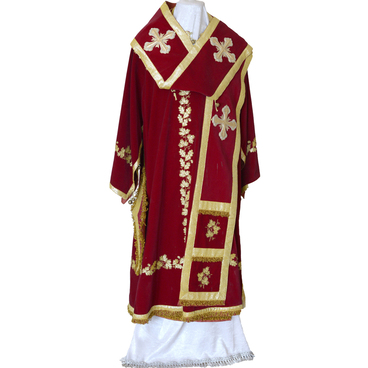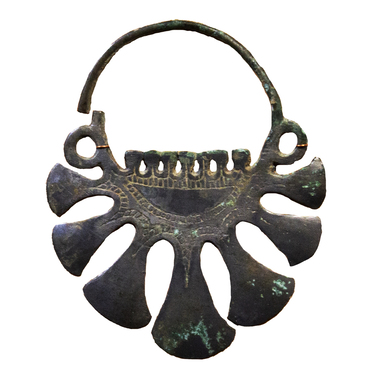In the Middle Ages, metal fibulae replaced buttons and other fasteners. They fastened the flaps of raincoats, belts, collars of shirts, dresses, and wide sleeves.
Fibulae decorated with various ornaments or insets were also worn as jewels. Gold or silver fasteners were considered the most luxurious, only rich and noble people could afford them, but bronze jewelry was cheaper.
In the 6th–7th centuries, the so-called fingered fibulae were used. They consisted of two metal shields with a short bow between them, a needle, a receiver for it, and a spring that kept the fastener closed. The upper shield resembled the shape of a human palm with fingers spread out, hence the name “fingered”. There were usually five protrusions on the shield of the fibula, a little less often — seven.
Among the Germanic tribes, it was customary to depict the heads of animals or mythical creatures on the fibula. The Slavs simplified the fasteners and began to decorate them with simple rounded “fingers” without drawings.
Fibulae decorated with various ornaments or insets were also worn as jewels. Gold or silver fasteners were considered the most luxurious, only rich and noble people could afford them, but bronze jewelry was cheaper.
In the 6th–7th centuries, the so-called fingered fibulae were used. They consisted of two metal shields with a short bow between them, a needle, a receiver for it, and a spring that kept the fastener closed. The upper shield resembled the shape of a human palm with fingers spread out, hence the name “fingered”. There were usually five protrusions on the shield of the fibula, a little less often — seven.
Among the Germanic tribes, it was customary to depict the heads of animals or mythical creatures on the fibula. The Slavs simplified the fasteners and began to decorate them with simple rounded “fingers” without drawings.
Depending on the type of bow, fibulae are divided into elbowed, onion-shaped, zoomorphic (in the form of animals), anthropomorphic (figures of people), ring-shaped, disc-shaped, serpentine, crossbow and others. Arch-shaped fibulae are the oldest known to archaeologists.
The fibula at the exhibit belongs to the so-called Moshchiny type. The Moshchiny culture is the archaeological culture of the Dnieper Balts of the Iron Age, who lived in the 4th–7th centuries in the territories of modern Kaluga, Oryol, and Tula oblasts. The culture was formed during the period of the great migration of peoples when the Hunnic nomadic hordes moved to the west and the Germanic tribes — to the Roman Empire. The culture got its name from the ancient settlement near the village of Moshchiny in the Mosalsky district of the Kaluga oblast.
Archeologists usually find monuments of the Moshchiny culture in the Upper Oka basin before the Protva River flows into it. During this period, metallurgical production was actively developing, people learned to get bronze — an artificial alloy of copper and tin. There were no copper ore deposits on the territory of the Oryol oblast, so metals were brought there from the southern regions.
The fibula at the exhibit belongs to the so-called Moshchiny type. The Moshchiny culture is the archaeological culture of the Dnieper Balts of the Iron Age, who lived in the 4th–7th centuries in the territories of modern Kaluga, Oryol, and Tula oblasts. The culture was formed during the period of the great migration of peoples when the Hunnic nomadic hordes moved to the west and the Germanic tribes — to the Roman Empire. The culture got its name from the ancient settlement near the village of Moshchiny in the Mosalsky district of the Kaluga oblast.
Archeologists usually find monuments of the Moshchiny culture in the Upper Oka basin before the Protva River flows into it. During this period, metallurgical production was actively developing, people learned to get bronze — an artificial alloy of copper and tin. There were no copper ore deposits on the territory of the Oryol oblast, so metals were brought there from the southern regions.



